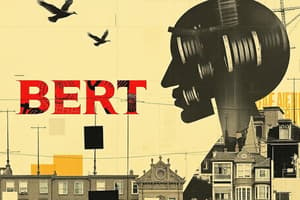Podcast
Questions and Answers
What does BERT stand for?
What does BERT stand for?
- Bidirectional Encoder Representations from Neural Networks
- Bidirectional Encoder Representations from Transformers (correct)
- Bidirectional Encoder Representations from RNNs
- Bidirectional Encoder Representations for Time Series
What is the capability of BERT that is enabled by the introduction of Transformers?
What is the capability of BERT that is enabled by the introduction of Transformers?
- Sequential input processing
- Attention mechanisms
- Bidirectionality (correct)
- Recurrent processing
What type of data can Transformers handle?
What type of data can Transformers handle?
- Only audio data
- Only image data
- Sequential data such as natural language text or time series data (correct)
- Only sequential data
What is the paper that introduced Transformers?
What is the paper that introduced Transformers?
What is the key advantage of Transformers over traditional RNNs?
What is the key advantage of Transformers over traditional RNNs?
What is the primary function of the feedback loop in RNNs?
What is the primary function of the feedback loop in RNNs?
What is the architecture of RNNs similar to?
What is the architecture of RNNs similar to?
What is a key application of Transformers in NLP?
What is a key application of Transformers in NLP?
What is the main purpose of word embeddings?
What is the main purpose of word embeddings?
Which of the following is NOT a benefit of word embeddings?
Which of the following is NOT a benefit of word embeddings?
What is BERT?
What is BERT?
What is the main difference between statistical methods and neural network methods for learning word embeddings?
What is the main difference between statistical methods and neural network methods for learning word embeddings?
What is the purpose of TF-IDF?
What is the purpose of TF-IDF?
What is the advantage of using word embeddings in machine learning models?
What is the advantage of using word embeddings in machine learning models?
What is the primary focus of Word2Vec and GloVe?
What is the primary focus of Word2Vec and GloVe?
What is a characteristic of word embeddings?
What is a characteristic of word embeddings?
What is the main challenge faced by traditional Recurrent Neural Networks (RNNs)?
What is the main challenge faced by traditional Recurrent Neural Networks (RNNs)?
What problem do Long Short-Term Memory (LSTM) networks and Gated Recurrent Units (GRUs) address in RNNs?
What problem do Long Short-Term Memory (LSTM) networks and Gated Recurrent Units (GRUs) address in RNNs?
What is the main task of Coreference Resolution (CR)?
What is the main task of Coreference Resolution (CR)?
What is BERT used for by Google?
What is BERT used for by Google?
What is a limitation of traditional RNNs that makes them not good at retaining information?
What is a limitation of traditional RNNs that makes them not good at retaining information?
What is the benefit of using LSTMs and GRUs in RNNs?
What is the benefit of using LSTMs and GRUs in RNNs?
Flashcards are hidden until you start studying
Study Notes
BERT (Bidirectional Encoder Representations from Transformers)
- BERT is a deep learning model based on Transformers, which enables it to read input text in both directions (left-to-right and right-to-left) simultaneously.
- This capability is known as bidirectionality and is enabled by the introduction of Transformers.
Transformers
- Transformers are a type of deep learning model architecture introduced in 2017, designed to handle sequential data like natural language text or time series data.
- They use attention mechanisms to capture dependencies between elements in the sequence, enabling them to capture long-range dependencies more effectively than RNNs or CNNs.
- Transformers have become the backbone of many state-of-the-art deep learning models in natural language processing (NLP), including BERT, GPT, and others.
Recurrent Neural Networks (RNNs)
- RNNs are good at modeling sequential data like text, audio, or time series data.
- They have a feedback loop, enabling them to have memory, but they suffer from short-term memory and are not good at retaining it long enough.
Word Embeddings
- Word Embeddings represent words as numerical vectors, capturing their meanings and semantic relationships.
- Similar words have similar vector representations, while dissimilar words have different representations.
- Word Embeddings enable computers to grasp relationships between words, handle unseen words, and are efficient for computations within machine learning models.
Word Embeddings Approaches
- Statistical Methods: Techniques like TF-IDF capture a word's importance in a document based on its frequency and how often it appears in other documents.
- Neural Network Methods: Powerful algorithms like Word2Vec and GloVe analyze large text corpora to learn word associations and develop vector representations that capture semantic relationships.
BERT Language Model
- BERT is a machine learning framework for natural language processing (NLP) that can process new information with the context of prior steps.
Recurrent Neural Networks (RNNs) Continued
- Coreference Resolution (CR) is the task of finding all linguistic expressions that refer to the same real-world entity in a given text.
Types of RNNs
- There are several types of RNNs, including long short-term memory (LSTM) networks and gated recurrent units (GRUs), designed to address the problem of vanishing gradients in RNNs.
BERT Uses
- BERT is used by Google to enhance how user search phrases are interpreted, exceling in tasks like question answering, abstract summarization, sentence prediction, and conversational response generation.
Studying That Suits You
Use AI to generate personalized quizzes and flashcards to suit your learning preferences.




